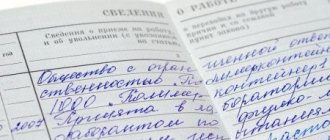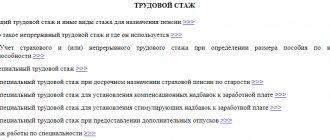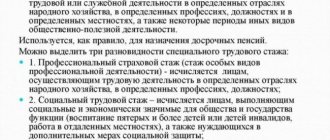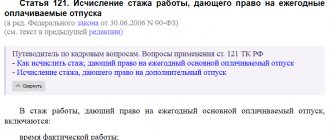Determination of insurance period
According to the concept of such length of service, all periods of employment available to a particular citizen of the Russian Federation are combined, as well as other cases when deductions were made to the Pension Fund account.
Thus, it is incorrect to understand by insurance experience only those periods of time when a person was officially employed and working - this concept unites more extensive periods of life when a person served in the army, was on maternity leave, on sick leave, etc. d. Of course, each of these time periods has its own nuances for calculating length of service. For every person, the concept of insurance coverage becomes relevant from the moment of the first deduction to the social insurance fund - most often this happens when applying for a first job.
Insurance experience can be of great importance for such life situations:
- calculating the amount of benefits for a limited period of disability (this often includes diseases that can subsequently lead to disability);
- to obtain the right to calculate a pension and the possibility of making a correct calculation of the due monthly payment amount;
- to calculate the amount of the amount paid at the birth of a child.
How to find out your length of service and whether you need to calculate it yourself
Data on the insurance experience of persons registered with the Pension Fund comes mainly from employers as part of personalized accounting information. Persons paying fixed contributions are also included in the Pension Fund, so the necessary information about the length of service of most citizens in the Pension Fund is available and can be obtained there:
- or by written request;
- or through an electronic account.
in calculating the insurance period yourself. When all the conditions required for granting a pension are met, the Pension Fund must check, using the documents submitted by the citizen, the correctness of the information he has and, if necessary, make all the necessary adjustments, focusing on the most beneficial option for the pensioner to take into account the insurance period and other circumstances.
What is included in the insurance period
The length of service, which is called labor service and is taken into account when calculating insurance coverage, includes the following periods of time:
- Segments (periods) during which a person worked or conducted other activities exclusively in Russia. A prerequisite for the possibility of accounting for them is the presence of deductions of insurance contributions to the Pension Fund. Such contributions could be transferred either by the person’s employer or independently.
- Periods during which a person worked outside the country (and, regardless of the place, country and state in which this happened) in cases that are separately stipulated by law or confirmed by international treaties signed and valid at the time of work. It also provides for taking into account such length of service if a specific person made contributions to the Pension Fund.
In addition, insurance experience may include:
- Time of military service, or any other service that, according to the regulatory law, can be equated to it.
- The period when a person received benefits accrued due to the inability to temporarily work.
- The period during which each child was cared for. When a citizen has more than one child and the total can be quite an impressive number, the existing provisions clearly provide for the maximum value that can be taken in the calculation - it is only 6 years.
- The time during which unemployment benefits were received or participation in civilian work (which was paid), relocation to another place of residence (if there is documentary evidence of a referral to this place from the employment service) in the appropriate direction.
- The time during which the person was held in custody (if such a procedure is subsequently proven to be unfounded), was repressed or served a sentence.
- The period of time during which care is provided for a person who has reached the age of 80, a disabled person of group I, or a disabled child.
- The time during which a person did not make contributions to the Pension Fund due to cohabitation with a spouse who served in military service.
- The period when living with a husband (wife) sent to work in a diplomatic mission or consular office, various trade missions.
- The time at which the operational work took place.
- The time during which persons were temporarily suspended from performing work in their positions due to criminal liability and were subsequently rehabilitated.
How does length of service affect the calculation of pensions?
With the introduction of the Federal Law “On Labor Pensions in the Russian Federation” dated December 17, 2001 No. 173-FZ, in 2002 the length of service taken into account for the old-age pension began to be determined in a new way. Its main function was to establish the right to receive a pension. It began to be called insurance, and its distinctive feature was that it was linked to the fact of payment of insurance premiums to the Pension Fund during this period. At the same time, the amount of the pension began to depend not on length of service, but on the amount of contributions paid.
The minimum insurance period required to obtain the right to a pension was determined in Law No. 173-FZ to be 5 years. It was applied until 2015, from the beginning of which the Federal Law “On Insurance Pensions” dated December 28, 2013 No. 400-FZ came into force, establishing 15 years of experience as the minimum required and a transition period for its full application.
A transitional period has been established from 2015 to 2024, during which the length of the insurance period giving the right to receive a pension increases by 1 year annually. Thus, in 2015 its duration was 6 years, in 2016 - 7 years. In 2024, as a result of this growth, the minimum required insurance period will become 15 years.
Legislative documents regulating insurance experience issues
The list of documents regulating and defining the procedure for calculating length of service is represented by laws relating to the following points:
- pension provisions;
- insurance accounting law;
- on the rules and methods for calculating length of service to calculate the amount of the pension;
- about the required documents provided to resolve issues related to pensions;
- regulations on the types of work, performing which you can qualify for an earlier pension accrual than is required in typical situations;
- calculation of pensions on benefits;
- regulations regarding work books and instructions for their preparation;
- list of jobs eligible for preferential pensions;
- calculation, recalculation of pensions after accrual and payments.
The legislative framework
The fundamental regulatory and legal documents that help determine the procedure for calculating the insurance pension and accounting for length of service are the following federal documents:
- Federal Law of 1996 “On individual registration in the state pension insurance system”;
- Federal Law of 1999 “On Compulsory Social Insurance”;
- Federal Law of 2001 “On Compulsory Pension Insurance in Russia”;
- Federal Law of 2001 “On Labor Pensions”;
- Federal Law of 2013 “On Insurance Pensions”.
The above also includes a list of federal laws that were adopted in two thousand and sixteen.
According to state legal documents, the insurance period is calculated for the following citizens:
- Pension benefit for the loss of a breadwinner - accruals are made to family members with lost legal capacity who were supported by the insured citizen;
- For civilians insured under the compulsory pension insurance system;
- For people with foreign citizenship who do not have Russian citizenship, but reside permanently in Russia . The only condition is compliance with the terms of the legislative documents on old-age insurance benefits.
Varieties of SS
At the moment, there is no clear division of insurance experience into its types. Based on current laws, it can be classified into the following types (all of them involve payment of a contribution to the Pension Fund):
- general, which includes the duration of work and performance of one’s duties;
- special, consisting of working in more difficult conditions;
Also, according to the main acts and regulations, it is possible to define the following two types of experience related to insurance:
- professional – represents the sum of the time spent working in special conditions with payment of the required amounts;
- for length of service - in such a situation, you can retire without taking into account the person’s age, given the fact that he will resign from the very place for which his pension payment is calculated.
How to determine the number of complete years and months
Paragraph 23 of the Rules states that the periods included in the insurance period should be calculated in calendar order based on full months (30 days) and a full year (12 months). In this case, every 30 days must be converted into full months, and every 12 months - into full years.
In practice, different translation techniques are used. One of the most common is as follows. Each calendar month is considered a full month, regardless of the number of days. So, a full month is considered to be the period from January 1 to January 31, from February 1 to February 28 (if the year is not a leap year), etc.
The number of days in incomplete months is added, and the result is divided by 30. For example, in the first month of the period 28 days were worked, and in the last month - 17 days. A total of 45 days were worked in the period (28 days + 17 days). It is believed that 45 days is one full month and 15 days (45 days: 30 days = 1 month + 15 days).
How is insurance experience calculated?
Regarding the calculation method, I would like to note the following important points:
- The main attention when calculating is paid to the marks in the work book.
- If the former employee carried out activities that were not reflected in the corresponding record, then a confirming certificate is provided for the calculation process (and indeed the possibility of accounting for this work).
- It often happens that a certain person during a specific period of time worked in more than one place (two, sometimes three) or, in parallel with work, could provide care for persons of a certain category, which can also be included in the length of service. In such cases, a citizen has the right to independently determine what type of work or activity for this time period he wants to include in calculating his pension payments.
- When calculating length of service, only a clearly limited list of work and other conditions for the possibility of calculating a pension are taken into account. If your occupation does not fall within this list, it will not be taken into account.
The procedure for confirming experience
If personalized accounting information is incomplete or insufficient to take into account all the circumstances relevant to the assignment of a pension, they can be supplemented with documents. In this case, the document may be in electronic form.
The requirements for the preparation of such documents are described in detail in the sections of Government Resolution No. 1015 dated 02.10.2014. These include:
- work books;
- labor and civil contracts;
- certificates from place of work or service;
- certificates from other bodies and persons.
If it is not possible to obtain documents, it is permissible to take into account data on insurance experience based on testimony. However, witnesses do not have the right to evaluate working conditions.
Documents for accrual of SS
The main documents that you will need to accrue insurance experience are as follows:
- passport;
- employment history;
- documents issued by the employer confirming the implementation of activities, if it is not reflected in the work book.
In special cases, the following documents may be needed:
- certificate of average earnings (the document reflects a period equal to 60 consecutive months);
- a certificate stating that family members who were unable to work were dependent on the person;
- document confirming place of residence or temporary stay;
- if a person’s last name, first name or patronymic changed during his life, then documents confirming their change (marriage certificate, certificate of voluntary change of last name);
- a certificate stating that the person has been diagnosed with a disability or has been given a certain degree of restriction on possible work.
How to calculate the insurance period if an employee refuses a paper work book
What if in 2021 an employee submits an application asking to provide information about his work activities electronically? In this case, you need to give the employee his paper work record book and inform him that now he is responsible for its safety. There is a slight change in the article of the Labor Code: the number of documents that an employee presents when applying for a job includes not only a work book, but “and/or information about work activity.” The same changes are expected in Order of the Ministry of Health and Social Development No. 91, which determines how and on the basis of what documents the insurance period is calculated. Let us remind you that an employee can receive information about his work activity from the employer (there will be information only about the last place of work), as well as in the multifunctional center, the Pension Fund and in his personal account on the government services website. The employer, in turn, will receive this information only from the hands of the person applying for the job. After the calculations are completed and the insurance period is entered into the personal T-2 card, the documents are returned to the employee. Information on labor activity as part of the new SZV-TD reporting will also be included in the procedure for forming the insurance period for the assignment of benefits.
Example of calculation of insurance period
As an example of calculation, let’s take a specific case: citizen Ivan Sergeevich Petrov carried out the following activities during his life:
- 05.1992-12.08.1996 – Progress LLC.
- 08.1996-26.10.2001 – operated as an individual entrepreneur.
- 02.2002-23.05.2003 – cared for his father, who was disabled group I.
- 06.2003-10.05.2017 – JSC “Dream”.
- 03.2007-30.06.2010 – worked part-time at Karavay LLC.
When calculating the insurance length of Petrov I.S. will be:
- at Progress LLC - 4 full years, 3 months and 3 days.
- activity as an individual entrepreneur – 5 full years, 2 months and 13 days.
- father's care – full 1 year, 3 months and 22 days.
- work at JSC "Dream" - a full 14 years, 11 months and 10 days.
- part-time activities at Karavay LLC - 3 full years, 3 months and 7 days.
As you can see, the last two places of work overlap in a certain period of time.
For the calculation, the citizen chose JSC “Dream”. Thus, after a general calculation, Petrov I.S.’s insurance experience amounted to 25 full years, 8 months and 18 days.
For more information about the minimum period of insurance coverage for payment of a pension and how it can be extended, see this video: So
, when calculating the insurance period, it is necessary to take into account all periods that can be taken into account and how a separate type of activity is reflected in the legislation. To be included in the total length of service, any work, care or other employment must have documentary evidence of its implementation.
How to calculate
The procedure for calculating the insurance period is regulated by Art. 13 Federal Law No. 400. It provides the following:
- calculation is made according to the calendar principle;
- self-employed citizens or citizens working under a contract with an individual accumulate experience if they have paid contributions to the Pension Fund;
- if a citizen has applied for a pension in another country, using certain periods of work, then in Russia these periods can no longer be applied;
- people who have length of service obtained before the 2015 changes have the right to decide how to calculate it - according to the new laws or the old ones.
Periods of work activity after the introduction of individual accounting and SNILS are subject to automatic confirmation based on the information recorded on the Russian’s personal account.
The calculation formula is elementary. All periods that can be counted as production are added up. The result obtained will be the insurance period.
Calculation example
Anna was officially employed for 20 years. During her working life, she gave birth to 2 children, with each of whom she was on maternity leave for 36 months.
After that, Anna became an individual entrepreneur and worked as an individual entrepreneur for 7 years. Moreover, out of these 7 years, she worked part-time for 2 years.
Its output will be calculated as follows:
- The work done while caring for a child is counted only for the first year and a half. During 2 maternity leaves, Anna accumulated 3 years of experience.
- If a person works part-time as an individual entrepreneur, the output is not counted, since there are no transfers to the Pension Fund.
- We sum up the difference of 20 and 3 with the difference of 7 and 2. The result is that Anna has accumulated 22 years of output.
The main document that confirms periods of work is still considered the work book. The information reflected in the document is checked by employees of the Pension Fund of the Russian Federation and taken into account when calculating length of service (if the employer made contributions to the Pension Fund). If a citizen meets the minimum length of service requirements, he is assigned an insurance pension, the amount of which depends on the length of work and earnings.
Regarding military service
According to paragraph 3 of Article 10 of the Federal Law of May 27, 1998 N 76-FZ “On the status of military personnel”:
The time spent by citizens in military service under a contract is counted in their total length of service, included in the length of service of a civil servant and in the work experience in their specialty at the rate of one day of military service for one day of work , and the time spent by citizens in military service by conscription (in including officers called up for military service in accordance with the decree of the President of the Russian Federation) - one day of military service for two days of work .
However, there is also such a thing as insurance experience. It replaced the length of service from January 1, 2007. Until January 1, 2007, 1 day of service under a contract was counted as 1 day in the insurance and work experience, and 1 day of conscription service was counted as 1 day in the insurance period, and as 2 days in the work experience. Also, if the length of service before January 1, 2007 is greater than the insurance period, it will be taken into account.
Our calculator asks you to select the most common periods of military service. However, in specific cases, the service may not last the even periods indicated in the list, but more precise ones, containing, in addition to years, also months and days. This is especially true for contract service. In this case, we recommend that you use the “Additional periods” block instead of selecting a value from the block regarding military service. In the “Additional periods” block, you can set the beginning and end of the period of military service under the contract, in which case the calculation will be as accurate as possible.
Types of special working conditions
Special work experience includes periods of work (Articles 30 and 31 of the Law of the Russian Federation dated December 28, 2013 No. 400-FZ):
- underground, in harmful conditions, in hot workshops;
To learn about what working conditions should be considered harmful, read the material “What refers to harmful working conditions (nuances)?”
- in difficult conditions;
- women - drivers of special (construction, road and loading and unloading) equipment;
- women workers in the textile industry with hard and intensive work;
- for direct transportation by rail, in the subway, as well as on freight transport used for the removal of minerals from their mining sites;
- on field geological exploration, survey, forest management and other similar work;
- in logging and timber rafting;
- machine operators for loading and unloading operations in ports;
- seafaring crews of long-distance vessels;
- drivers of urban passenger transport;
- on underground and open-pit mining and construction of mines and mines;
- for the extraction and processing of sea products on fishing fleet vessels;
- in the flight crew of civil aviation vessels;
- for direct flight control of civil aviation vessels;
- maintenance personnel of civil aviation vessels;
- rescuers of professionally functioning emergency rescue services who actually took part in the liquidation of emergency situations;
- with convicts serving sentences in places of deprivation of liberty;
- in fire services;
- teachers of children's institutions;
- in healthcare institutions;
- creative nature in theaters and other entertainment organizations;
- test pilots of all types of aircraft.
Calculation of special insurance experience: special positions and professions
There are no clear criteria by which one can say with certainty that a profession or position is “harmful”. However, the law prescribes focusing on the following indicators:
- the nature of the work performed;
- production conditions associated with exposure to harmful and life-threatening factors;
- service in the fire department;
- service in the penitentiary system;
- pedagogical activity;
- work in treatment institutions;
- performing work at an enterprise located in the Far North or similar areas.
How is experience confirmed?
Since 2002, all data on employment, length of service and accruals have been entered into a unified personalized accounting system. The data is stored in an electronic database for each employee (and for this you need a SNILS - all data is linked to this number).
However, the main document to confirm work experience remains the work book.
. It records all the data - the date of hiring, transfer to another position, the date and reason for dismissal, order numbers. You should not rely on an electronic work book - they have only existed since 2021, and all previous work experience was recorded in paper documents.
Pension Fund employees check work records very carefully
. And if they find an illegible record, a “floating” seal or other violations, the person will have to collect certificates of work. Usually, a certificate of employment can be requested from the employer, but most often we are talking about the period of the USSR or the 90s, and many enterprises have since closed. In this case, you need to go to the appropriate archive and request a certificate there.
But in the 90s, the archives were not maintained very well, and many documents did not reach them. Then to prove your experience you will have to use other possibilities:
- prove your experience through other documents. For example, membership books, union cards or other documents that directly or indirectly prove the fact of employment may be useful;
- find witnesses. The written testimony of two people who worked at the same time at the same enterprise is sufficient. It will be necessary to take from them not only their testimony, but also documents about their employment (and everything should be in order with them).
For entrepreneurs, proof of insurance experience will be certificates of payment of insurance premiums
. This is a serious problem - data on entrepreneurs for the period of the 90s has not been preserved in full, so it is better to save the maximum number of documents.
To confirm other periods that are counted towards length of service, you need to collect relevant documents, for example:
- military conscription service - military ID, certificate from the military registration and enlistment office, unit or headquarters;
- period of study – diploma, certificate, certificate from an educational institution;
- period of child care – child’s birth certificate, documents from the employer on leave;
- receiving unemployment benefits - a certificate from the employment service, etc.
It is best to start collecting documents before retirement age.
– then there will be only 3 months left for this. And a year before retirement, you can visit the Pension Fund, where a specialist will calculate your length of service and tell you what certificates and other documents you need to collect. In this case, a person will be able to apply for a pension literally immediately upon reaching retirement age.
Dependence of the amount of benefits on length of service
The amount of sick leave according to Art. 7 255 of the law directly depends on the length of the insurance period.
If an employee works in an organization and is temporarily disabled due to illness, injury, quarantine, prosthetics, or stay in a sanatorium-resort institution (for medical reasons), then:
- with up to 5 years of experience, he will receive a benefit in the amount of 60% of average earnings;
- with experience from 5 to 8 years – 80%;
- with over 8 years of experience - 100%.
The allowance for caring for a sick child is calculated in the same way:
- if a child is undergoing outpatient treatment, then benefits in the amount of 60, 80 and 100% are accrued only in the first 10 days of sick leave, and for subsequent days - in the amount of 50% of average earnings;
- When receiving treatment in a hospital, the amount of payments depends only on the length of service.
In case of temporary disability due to caring for an adult family member (outpatient), the amount of benefit is determined in the same way as when calculating sick leave due to the employee’s own illness.
In some cases, the amount of the benefit does not depend on length of service:
- if the disability arose due to an occupational disease or injury at work, then the benefit amount is 100% of average earnings;
- if an employee leaves the company, but 30 calendar days have not passed since the date of dismissal, he can also apply for sick leave - in this case, the benefit amount will be 60% of average earnings.
The insurance period is also taken into account when calculating maternity benefits: if a woman’s length of service is more than 6 months, then the amount of the benefit is 100% of average earnings, if less than six months, then no more than 1 minimum wage for a full calendar month of maternity leave.
Special insurance period for early retirement
From the previous material “Procedure for calculating insurance experience” you already know that according to the new pension legislation since 2015, two types of insurance experience have been distinguished:
insurance experience , which gives the right to assign an insurance pension and
special insurance experience - insurance experience that gives the right to assign an early old-age insurance pension.
In this material you will learn about the procedure for calculating special insurance experience for early retirement.
Features of the calculation of special insurance experience, which gives the right to assign an early old-age insurance pension, are contained in the “Rules for calculating periods of work, which gives the right to early assignment of an old-age labor pension...”, approved. Decree of the Government of the Russian Federation of July 11, 2002 No. 5161.
Rules for calculating special insurance experience for early retirement
Rule No. 1 for calculating the special insurance period for early retirement
The special insurance period includes periods of work performed continuously for a full working day (unless otherwise provided by law), subject to:
- payment of insurance contributions to the Pension Fund of the Russian Federation for these periods.
The following is equivalent to payment of insurance contributions to the Pension Fund of the Russian Federation:
- payment of insurance contributions for state social insurance before January 1, 1991
- single social tax (contribution) and
- a single tax on imputed income for certain types of activities.
Rule No. 2 for calculating the special insurance period for early retirement
Periods of work that give the right to early assignment of an old-age insurance pension, which was performed continuously during a full working day,
- are counted towards the insurance period in calendar order, unless otherwise provided by law.
In this case, the insurance period includes:
- periods of receiving state social insurance benefits during temporary disability, as well as
- periods of annual basic and additional paid leave.
The following cases of preferential calculation of special insurance length of service are exceptions:
- for persons who carried out medical and other activities to protect public health in health care institutions in the city, in rural areas and in an urban-type settlement (working village), one year of work in a rural area or in an urban-type settlement (working village) is counted towards the specified work experience for one year and three months with the required special insurance experience of 30 years 2;
- for persons who worked in structural divisions of healthcare institutions in positions according to the relevant List 3, one year of work is counted towards special insurance experience in one year and six months.
In the same manner, periods of work in the relevant positions in departments (groups, wards, mobile emergency medical teams) listed in paragraphs 1-3 of the List in organizations (structural divisions) specified in paragraph 6 of the “Calculation Rules” are counted as length of service. periods of work giving the right to early assignment of a labor pension to persons who carried out medical and other activities to protect the health of the population in health care institutions...”, approved. Decree of the Government of the Russian Federation of October 29, 2002 No. 781;
- for citizens who worked both in the Far North and in equivalent areas, a labor pension is established for 15 calendar years work in the Far North.
Moreover, each calendar year of work in areas equated to the regions of the Far North is considered to be nine months of work in the regions of the Far North 4.
Rule No. 3 for calculating the special insurance period for early retirement
Periods of work giving the right to early assignment of an old-age labor pension, which were performed:
- in part-time, but full-time mode due to a reduction in production volumes 5, as well as
- periods of work determined by the Ministry of Labor and Social Protection of the Russian Federation in agreement with the Pension Fund of the Russian Federation or
- provided for by lists that, due to labor organization conditions, cannot be carried out constantly,
are calculated based on time actually worked.
Rule No. 4 for calculating the special insurance period for early retirement
In case of early assignment of an old-age insurance pension in connection with field geological exploration, prospecting, topographic-geodetic, geophysical, hydrographic, hydrological, forest management and survey work
work in expeditions, parties, detachments, in sections and in brigades, the periods of said work directly in the field are taken into account in the following order:
- work from 6 months to one year - as one year;
- work less than 6 months - according to actual duration.
Rule No. 5 for calculating the special insurance period for early retirement
Periods of shift work that give the right to early assignment of an old-age insurance pension include:
- time of work on site,
- rest time between shifts in the rotational camp,
- travel time from the employer’s location or from the collection point to the place of work and back, as well as
- the time of inter-shift rest in a given calendar period of time.
In this case, the total working time (normal or reduced) for the accounting period (for a month, quarter or other longer period, but not more than for one year):
- should not exceed the normal number of working hours established by the Labor Code of the Russian Federation.
Rule No. 6 for calculating the special insurance period for early retirement
Periods of work on a rotational basis in the regions of the Far North and equivalent areas with the early assignment of an old-age insurance pension in accordance with paragraphs 2 and 6 of Part 1 of Art. 32 of the Federal Law “On Insurance Pensions” are calculated in calendar order, including:
- working hours directly on site,
- rest time between shifts in the rotational camp, as well as
- period of inter-shift rest and
- travel time from the employer’s location or from the collection point to the place of work and back.
Rule No. 7 for calculating the special insurance period for early retirement
When transferring an employee from a job that gives the right to early assignment of an old-age insurance pension to another job that does not give the right to the specified pension, in the same organization due to production needs for a period of no more than one month during a calendar year:
- such work is equivalent to the work preceding the translation.
Rule No. 8 for calculating the special insurance period for early retirement
are not included in periods of work that give the right to early assignment of an old-age pension if the employee was suspended for the following reasons:
- showing up at work under the influence of alcohol, drugs or toxic substances;
- on the basis of a medical report in connection with identified contraindications for performing the work provided for in the employment contract (except for the case when the pregnant woman did not work until the issue of her employment was resolved in accordance with the medical report);
- at the request of bodies and officials authorized by regulatory legal acts;
- if the employee has not undergone training and testing of knowledge and skills in the field of labor protection in the prescribed manner;
- if the employee has not undergone a mandatory preliminary or periodic medical examination in accordance with the established procedure;
- in other cases provided for by law.
Rule No. 9 for calculating the special insurance period for early retirement
Not included in periods of work that give the right to early assignment of an old-age insurance pension,
- periods of downtime (both due to the fault of the employer and the fault of the employee).
Rule No. 10 for calculating the special insurance period for early retirement
The probationary period when hiring a job that gives the right to early assignment of an old-age insurance pension,
- is included in the length of service regardless of whether the employee passed the test.
Rule No. 11 for calculating the special insurance period for early retirement
The period of initial vocational training or retraining (on-the-job) at workplaces in accordance with an apprenticeship contract is included in periods of work that give the right to early assignment of an old-age insurance pension in the following cases:
- when in Art. 30 of the Federal Law “On Insurance Pensions” or the Lists6 indicate production or certain types of work without listing the professions and positions of employees or
- workers are provided to perform certain work without specifying the names of professions or positions.
Rule No. 12 for calculating the special insurance period for early retirement
When transferring, in accordance with a medical report of a pregnant woman at her request, from a job that gives the right to early assignment of an old-age insurance pension, to a job that excludes exposure to unfavorable occupational hazards,
- such work is equivalent to the work preceding the translation.
The periods when the pregnant woman did not work until the issue of her employment was decided in accordance with the medical report are calculated in the same manner.
Rule No. 13 for calculating the special insurance period for early retirement
The length of service that gives the right to early assignment of an old-age insurance pension includes:
- time of paid forced absence due to illegal dismissal or
- transfer to another job and subsequent restoration to the previous job, giving the right to early assignment of an old-age insurance pension.
Rule No. 14 for calculating the special insurance period for early retirement
When calculating periods of underground work, which gives the right to an old-age pension regardless of age, if there are at least 25 years of such work in accordance with clause 11. 1 tbsp. 30 of the Federal Law “On Insurance Pensions in the Russian Federation”, persons
those who have not completed the underground work experience provided for in this paragraph, but have at least 10 years of it, the underground work experience is taken into account in the following order:
- every full year of work as a longwall miner, drifter, jackhammer operator, mining machine operator - for one year and three months;
- every full year of underground work provided for in List No. 17 - for 9 months.
In addition, the Federal Law “On Insurance Pensions” introduces a number of additional rules for including periods of work (activity) in the special insurance period, giving the right to an early old-age insurance pension in accordance with Art. 30 of the said law 8.
They are as follows:
- periods of work (activity) that occurred before January 1, 2015 are counted as length of service in the relevant types of work, giving the right to early assignment of an old-age insurance pension, provided that such work (activity) was recognized as giving the right to early assignment of a pension by law , operating during the period of its implementation;
- periods of work (activity) that took place before January 1, 2015 can be calculated using the calculation rules provided for by the legislation in force when assigning a pension during the period of performance of this work (activity);
- periods of work provided for in clauses 1-18, part 1, art. 30 of the Federal Law “On Insurance Pensions”9, which took place after January 1, 2013., are counted towards length of service in the relevant types of work, which gives the right to early assignment of an old-age insurance pension, subject to the accrual and payment by the policyholder of additional insurance premiums at the appropriate rates.
The insured's obligation to pay additional insurance premiums occurs if, based on the results of a special assessment of working conditions in the workplace for the work specified in clauses 1-18, part 1, art. 30 of the Federal Law “On Insurance Pensions”, assigned harmful or dangerous class 10.
From January 1, 2014 Art. 58.3 of the Federal Law “On Insurance Contributions to the Pension Fund of the Russian Federation, the Social Insurance Fund of the Russian Federation, the Federal Compulsory Medical Insurance Fund” dated July 24, 2009 No. 212-FZ11 establishes the following tariffs for additional insurance contributions:
| Class of working conditions | Subclass of working conditions | Additional insurance premium rate |
| Dangerous | 4 | 8,0% |
| 3.4 | 7,0% | |
| 3.3 | 6.0% | |
| 3.2 | 4,0% | |
| 3.1 | 2,0% | |
| Acceptable | 2 | 0,0% |
| Optimal | 1 | 0,0% |
In addition, from January 1, 2021, an alternative option for forming rights to early pension provision will be introduced by law
- in the form of non-state pension provision 12.
By agreement with the employees, the employer can conclude an early non-state pension agreement with a non-state pension fund (NPF) and transfer insurance contributions for the early pension provision of its employees to the NPF.
In this case, the employer is released from the obligation to pay additional insurance contributions to the Pension Fund of the Russian Federation.
In turn, if an employee has the right to an early old-age pension, the NPF is obliged to assign and pay such a pension in accordance with the terms of the pension agreement with the non-state pension fund.
1 Decree of the Government of the Russian Federation “On approval of the Rules for calculating periods of work giving the right to early assignment of an old-age labor pension in accordance with Articles 27 and 28 of the Federal Law “On Labor Pensions in the Russian Federation”” dated July 11, 2002 No. 516. 2 Paragraph 20 hours 1 tbsp. 30 of the Federal Law “On Insurance Pensions” dated December 28, 2013 No. 400-FZ. 3 List of structural units of healthcare institutions and positions of doctors and paramedical personnel, work in which during the year is counted towards the length of service giving the right to early assignment of an old-age pension, as a year and six months - an appendix to the Rules for calculating periods of work giving the right for the early assignment of an old-age labor pension to persons who carried out medical and other activities to protect the health of the population in health care institutions, in accordance with subparagraph. 20 clause 1 art. 27 of the Federal Law “On Labor Pensions in the Russian Federation”, approved. Decree of the Government of the Russian Federation of October 29, 2002 No. 781. 4 Clause 6, Part 1, Art. 32 of the Federal Law of December 28, 2013 No. 400-FZ “On Insurance Pensions”. 5 With the exception of work that gives the right to early assignment of an old-age labor pension in accordance with clauses 13 and 19-21, part 1, art. 30 of the Federal Law of December 28, 2013 No. 400-FZ “On Insurance Pensions”. 6 Resolution of the Cabinet of Ministers of the USSR of January 26, 1991 No. 10 “On approval of lists of production, work, professions, positions and indicators giving the right to preferential pension provision.” 7 List No. 1 of production, work, professions, positions and indicators in underground work, in work with especially harmful and especially difficult working conditions, employment in which gives the right to an old-age pension on preferential terms, approved. by resolution of the Cabinet of Ministers of the USSR of January 26, 1991 8 See Conditions for the appointment of early old-age insurance pensions. 9 In paragraphs 1-2 of Part 1 of Art. 30 of the Federal Law “On Insurance Pensions” are the periods of work indicated respectively in Lists No. 1 and No. 2, approved. Resolution of the Cabinet of Ministers of the USSR of January 26, 1991 No. 10; in clause 3-18, part 1, art. 30 of the law are the periods of work specified in the so-called “Small Lists”. 10 Federal Law of December 28, 2013 No. 426-FZ “On special assessment of working conditions.” 11 Federal Law of July 24, 2009 No. 212-FZ “On insurance contributions to the Pension Fund of the Russian Federation, the Social Insurance Fund of the Russian Federation, the Federal Compulsory Medical Insurance Fund.” 12 Federal Law of December 28, 2013 No. 410-FZ “On Amendments to the Federal Law “On Non-State Pension Funds” and certain legislative acts of the Russian Federation.”
If you have any questions about your work experience, or you find yourself in a difficult situation, then an online duty lawyer is ready to advise you on this issue for free.
If you have any questions about the violation of your rights, or you find yourself in a difficult life situation, then an online duty lawyer is ready to advise you on this issue for free.
INSURANCE EXPERIENCE
Who has the right to claim an insurance pension?
For each type of work, a minimum threshold is established that is required to obtain the right to apply for an insurance pension.
There are the following categories of citizens who are subject to social security legislation:
- persons who were insured and made regular contributions in accordance with Federal Law No. 167-FZ of December 15, 2001;
- military personnel and equivalent civil servants with at least 25 years of service in calendar terms;
- disabled people, subject to the loss of a breadwinner;
- foreigners and stateless persons, if they complied with the requirements of the law on compulsory pension insurance;
- spouses of employees performing their professional duties abroad for up to 5 years;
- disabled people with congenital defects or acquired as a result of professional activities; You can read more about the disability insurance pension here;
- heroine mothers, with at least 5 years of work experience.
This is interesting! The government has approved lists of professions, according to which their representatives have the right to early retirement while maintaining its amount.
Is it necessary to confirm all the experience at all?
The insurance period is needed only for one purpose - at the time of retirement it must be at least 12 years
. If the length of service is less, the person simply will not be able to apply for an insurance pension. Therefore, if the insurance period is enough for retirement, there is no longer a need to prove any additional periods after 2002 specifically for the period of service - this period of service will not affect the amount of the pension.
But work experience (that is, accumulated before 2002) can come in handy. In general, there are 2 options for calculating pensions for the years before 2002:
- The average salary for 60 months of continuous service is compared with the national average salary for the same months. The resulting coefficient (but not more than 1.2) is multiplied by a certain figure (average salary in 2001) and by the length of service coefficient. And the length of service coefficient is 0.55 for 25 years of experience for men and 20 years for women, and then increases by 0.01 for each year of experience from above. But little is included in these years - for example, study is not included there, like many other non-insurance periods;
- the average salary for 60 months of continuous service is multiplied by the length of service coefficient. The coefficient is calculated in the same way, but literally all periods of total work experience are included in the years. However, the pension calculated in this way is limited to the amount of 555.96 rubles (in 2002 prices). In fact, this option is beneficial for those who received a salary no more than 60-70% of the national average.
Thus, it makes sense to include study and other non-insurance periods only if
if a person’s salary in the periods before 2002 was not very high, then his pension is calculated according to the second option and each additional year of service will increase the payment.
If we are talking about confirming periods of work, it is better to do this in full - every year affects the amount of the pension in any of the calculation options (and the limit of 1.2 does not apply to length of service).
Other non-insurance periods that are included in the length of service should be confirmed if they give the right to additional pension points
. For example, extra points for children began to be given only in 2015 - and if a pensioner applied for a pension earlier and did not submit the birth certificates of his children to the Pension Fund, this must be done.
In any case, it is better to ask an employee of the Pension Fund about this - they always calculate different options and assign a pension according to where the payment will be the largest.











